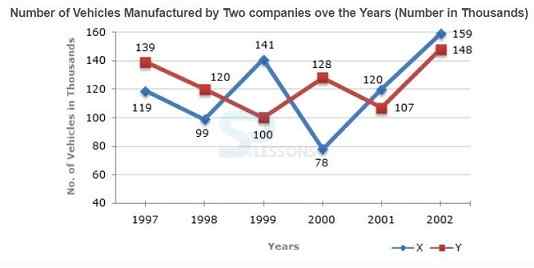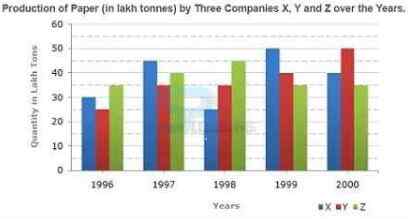 Introduction
Introduction
Institute of Banking Personnel Selection (IBPS) has announced a notification for the recruitment of IBPS RRB Officer (Scale I, Scale II, Scale III). Candidates who are interested and meet all eligibility criteria can read the Official Notification issued by IBPS. IBPS RRB Online Examination – Preliminary Exam would be held on 03.08.2019, 04.08.2019 and 11.08.2019.
The article IBPS RRB Data Interpretation Quiz Day 1 provides Data Interpretation pattern Questions, and it helps the candidates to devise effective preparation strategies, by focusing on their strengths and weaknesses in different topics and also useful to the candidates while preparing Various Insurance, Banking & Government Exams like SBI PO, SBI Clerk, SSC CPO, SSC CHSL.
 Quiz
Quiz
A school has four sections A, B, C, D of Class IX students.
The results of half yearly and annual examinations are shown in the table given below.
1. If the number of students passing an examination be considered a criterion for comparison of the difficulty level of two examinations, which of the following statements is true in this context?
| Result | No. of Students | |||
|---|---|---|---|---|
| Section A | Section B | Section C | Section D | |
| Students failed in both Exams | 28 | 23 | 17 | 27 |
| Students failed in half-yearly but passed in Annual Exams | 14 | 12 | 8 | 13 |
| Students passed in half-yearly but failed in Annual Exams | 6 | 17 | 9 | 15 |
| Students passed in both Exams | 64 | 55 | 46 | 76 |
-
A. Half yearly examinations were more difficult.
B. Annual examinations were more difficult.
C. Both the examinations had almost the same difficulty level.
D. The two examinations cannot be compared for difficulty level.
-
A. 336
B. 189
C. 335
D. 430
-
A. A Section
B. B Section
C. C Section
D. D Section
-
A. A Section
B. B Section
C. C Section
D. D Section
-
A. A section
B. B section
C. C section
D. D section
Study the following line graph and answer the questions based on it.
1. What is the difference between the number of vehicles manufactured by Company Y in 2000 and 2001 ?
-
A. 50000
B. 42000
C. 33000
D. 21000
-
A. 19000
B. 22000
C. 26000
D. 28000
-
A. 119333
B. 113666
C. 112778
D. 111223
-
A. 1997
B. 1998
C. 1999
D. 2000
-
A. 173
B. 164
C. 132
D. 97
The bar graph given below shows the data of the production of paper (in lakh tonnes) by three different companies X, Y and Z over the years.
1. For which of the following years, the percentage rise/fall in production from the previous year is the maximum for Company Y?
-
A. 1997
B. 1998
C. 1999
D. 2000
-
A. 1:1
B. 15:17
C. 23:25
D. 27:29
-
A. X
B. Y
C. Z
D. X and Z both
-
A. 1996
B. 1997
C. 1998
D. 1999
-
A. 30%
B. 45%
C. 50%
D. 60%
Other Articles
 Study Guide
Study Guide
| Competitive Exams - Study Guide | ||
|---|---|---|
| Category | ||
| Quantitative Aptitude | Reasoning Ability | General Awareness |
| Computer Awareness | English Knowledge | Banking Awareness |
| General Science | World of Words | Descriptive Test |
 Exams
Exams
| Competitive Exams - College Entrance Exams | |||
|---|---|---|---|
| Category | Notification | ||
| Diploma | NITC New Delhi | ||
| Click Here For – All India Entrance Exam Notifications | |||
 Daily CA
Daily CA
 Job-Alerts
Job-Alerts
 SP Quiz
SP Quiz
| Competitive Exams - Practice Sets | |
|---|---|
| Category | Quiz |
| English Language | Spotting Errors |
| Quant Aptitude | Time and Work Quiz |
| Reasoning Ability | Direction Sense |
| Insurance Awareness | Insurance Awareness |
 GK
GK
| General Knowledge for Competitive Examinations | |
|---|---|
| Topic | Name of the Article |
| GK - World | National International Significant Dates |
| Agricultural Commodities Largest Producers | |
| GK - India | Revolt – 1857 |
| Chalukya Dynasty and Pallava Dynasty | |
| GK - Abbreviations | Insurance Domain Abbreviations |
| Education Abbreviations | |
| GK - Banking & Insurance | Public Finance and Budget |
| Indian Banking and Indian Schemes Important Abbreviations 2019 | |
| GK - Science & Technology | Energy Transformation Devices |
| Indian Internet Service Providers | |







